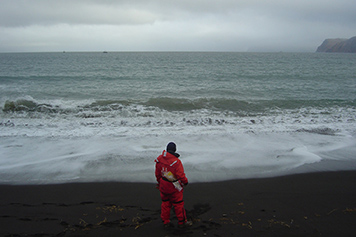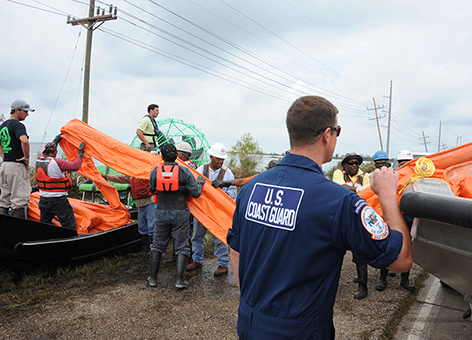
The government can’t stop working just because of an emergency. This means that federal agencies need to be prepared, with plans that account for every situation, to ensure our jobs always get done. This is called comprehensive continuity planning.
Continuity of operations plans cover everything from natural disasters like hurricanes and earthquakes, to fires and terrorist attacks. OR&R’s Disaster Preparedness Program works with NOAA’s Homeland Security Program Office to make sure we are ready for any possible scenario.
So what does a possible scenario look like? Imagine that a NOAA laboratory building caught fire. Nobody was hurt, but the building is damaged and may take days to repair. The scientists who work at the laboratory are worried because the fire damaged an industrial freezer holding sensitive and irreplaceable fish samples. If the fish thaw too fast they can’t be used in the experiment.
How would the scientists continue with their operations? Can they move the fish samples to another laboratory? Where is the closest one? Who do they need to call? How do they transport them? And how do they do it safely?
COOP and Public Safety: A Scenario
Now what if instead of a NOAA laboratory it was a city’s snow plow garage that caught fire? What if this happened during a blizzard? How do they clear the streets? How would the government provide critical help to its citizens?
What if suddenly the Air Traffic Control computer system failed and there was no available weather information and planes couldn't fly? What if your bank stopped getting your direct deposit payroll from your employer, or there was no one to respond to major emergencies and disaster that exceeded our local emergency response capacity, or no ability to process the medical insurance claims for a parent or grandparent as part of their social security benefit? These are just a few examples of a small number of government operations that happen so routinely that we don’t even seem to recognize that they happen in part because of good planning and effective continuity of operations planning. The truth is that weather forecasting, air safety, many banking functions and protections, lifesaving support during emergencies, social security health benefits, and many other services are part of the federal government.
This is where continuity plans come in, for government agencies who may be unable to perform critical services before, during, and after an emergency. We call this Continuity of Operations Planning, or COOP.
A continuity plan addresses emergencies from an all-hazards approach that enables individual departments to perform essential functions for up to 30 days, or until things get back to normal. continuity plans are living documents that are adaptable and flexible.
Department and agency plans will include procedures that identify and maintain the following information:
- Essential Functions: What does this department need to do?
- Orders of Succession: Who is going to do it? This includes a chain of command.
- Delegations of Authority: Who makes decisions? What kinds of decisions can they make? Who has the final call?
- Continuity Facilities: If your facility is damaged, where else can you go? Where is your backup location?
- Continuity Communications: Agencies work together, so who do you call to coordinate? When electricity or phone lines are down, how do you get in touch? What are your backup methods?
- Vital Records Management: What technologies do you use to store reports? What if your computer is down, do you have paper copies? What are your backup options?
- Human Capital: Who is on call for emergencies? What are their roles and responsibilities?
- Tests, Training, and Exercises: When was the last time you had a drill? Are you ready for the real thing?
- Devolution: If your entire department is out of commission, who else can do your job?
- Reconstitution: When and how do things go back to normal?
A NOAA COOP can be activated in response to a wide range of events — anything that makes it impossible for employees to work normally on behalf of the American public.
It’s a bit like magic because we don’t see the work people do to keep the operations going 24 hours a day each day of the year. It all happens out of our sight, making it seem that these expected routine services are just part of our daily life. Maybe it is magic. In truth, computer systems fail or are maliciously attacked, power systems fail, natural disasters happen, and many other potential impacts to essential government services are minimized and prevented through contingency planning and the development of an effective Continuation of Operations plan that provides for alternative means to maintain government and private sector operations 24 hours a day, every day.
FEMA’s Continuity Guidance Circular is one of many resources available to agencies looking to refine these plans. Here at NOAA, the Disaster Preparedness Program provides support and expertise to help the National Ocean Service work through worst-case scenarios.
While we can’t always prevent emergencies, we can be as prepared as possible. To do this, we use COOP as an adaptable tool that helps agencies work through disasters.


